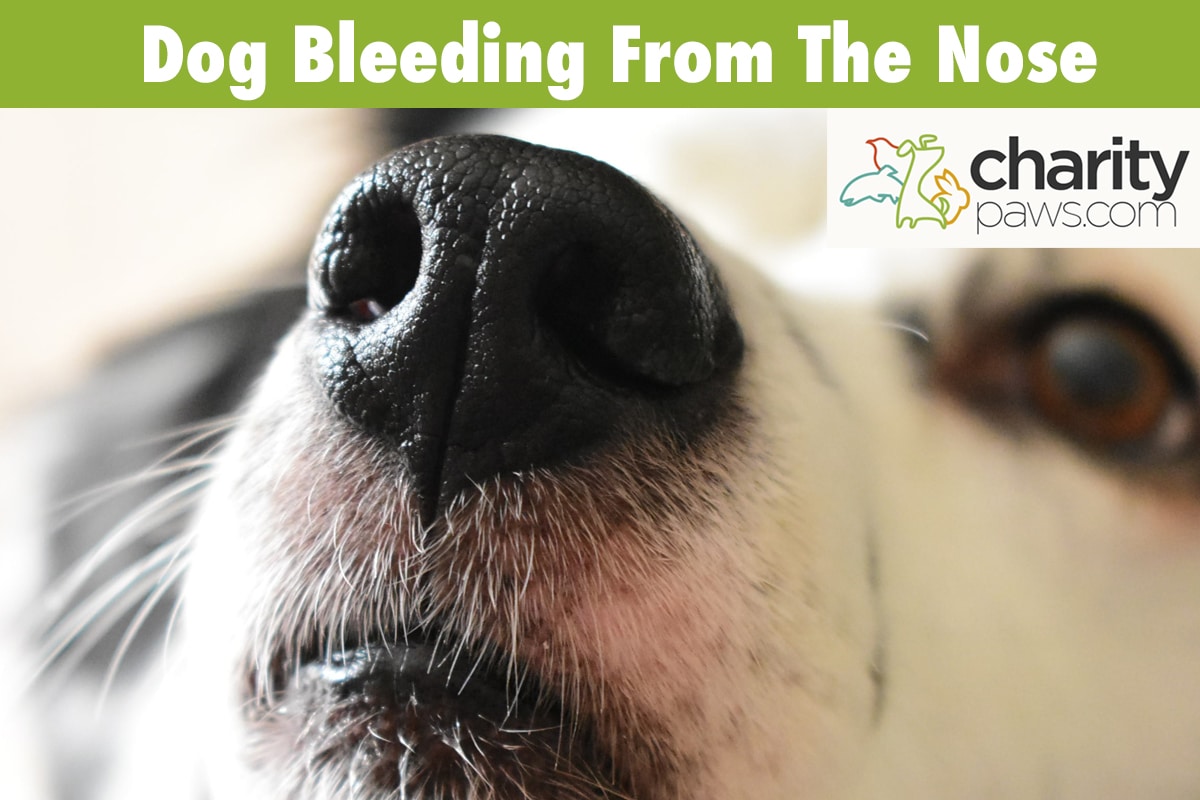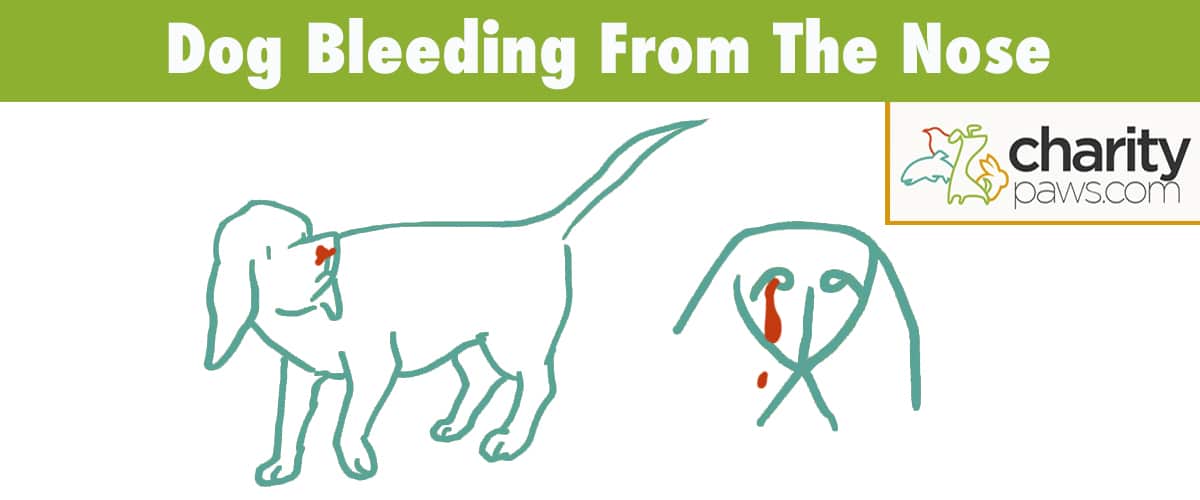There is nothing more shocking than looking over at your furry friend, only to discover a stream of blood trickling from their nose.
While we know we can get nosebleeds from common irritants like allergies or dry skin, it is not as straightforward for our canine companions.
So why is your dog bleeding from the nose, and what could this mean for them going forward?
In this article we will introduce you to the details of nosebleeds in dogs, and help you better understand the many factors behind this strange occurrence.
Do Dogs Get Nosebleeds?

Yes, our dogs can get nosebleeds just like you and I can.
Nosebleeds in dogs, or epistaxis, can occur suddenly in an otherwise healthy furry friend.
Their occurrence is often startling and concerning for the pet owner, as it is not every day that you see a stream of blood falling from your pup’s snout.
While nosebleeds in dogs can occur for benign reasons just like they can in humans, it’s still important to take notice and offer immediate care.
Some nosebleeds in dogs develop as a result of underlying illness, so it’s important to take each nosebleed seriously.
Is your dog bleeding on top of the nose, check out Kennel Nose in Dogs.
Are Nosebleeds An Emergency In Dogs?
As we mentioned above, some nosebleeds in dogs are completely harmless.
Dogs can bump their nose on random objects just like you and I can, causing their snout to bleed unexpectedly.
However, if your dog’s nose bleed develops without an obvious cause, it is always possible that it is a result of an underlying health complication.
These factors range from mild illness to serious medical threats, so we always suggest reaching out to your vet with each unexplained nosebleed.
Any nosebleed that will not stop should also be considered an emergency, even if it is a result of a trauma you witnessed.
Dogs can lose a large amount of blood if their nose continues to bleed, especially if their trauma caused significant injury to the area.
Signs Of A Nosebleed In Dogs
The blood coming from your dog’s nose may be an obvious symptom, but there are other signs of a nosebleed to be on the lookout for as well.
You may not catch your dog while they are having an active nosebleed, so it’s important to be aware of both the subtle signs and the signs in the aftermath.
Some of the most common symptoms of a nosebleed in dogs include:
- A flow or drips of blood coming from your dog’s nasal area
- Crusted blood around your dog’s nostrils, or even the area surrounding the nose
- Pawing at the nose or face
- Swelling of your dog’s nose or face
- Trauma or injury to the face or nose
- Vomit that contains blood or is dark in color
- Tiny drops of blood found around your home
If your dog is experiencing any of the above symptoms, we always suggest reaching out to your veterinarian for further guidance.
Even if you have just witnessed a trauma that caused your dog’s nose to bleed, your vet can still offer you instructions based on the situation.
No matter what, speaking with your vet is always the best solution.
My Dog’s Nose Is Bleeding, What Should I Do?
If your canine friend suddenly begins to bleed from the nose, you are likely wondering how you should best jump into action.
While we still suggest reaching out to your vet once the bleeding is under control, there are a few first aid options that you can administer at home.
At home first aid for a dog with a nosebleed can include:
- Look for any obvious trauma to your dog’s nose or facial region. If you do find any obvious injuries, you can focus on these areas to stop the bleeding.
- If your dog will allow it, try to look around the nose and in the mouth for any hidden injuries. This will help you in describing any injuries to your vet.
- Be sure to keep your dog as calm as possible while you attempt to stop the bleed. The higher their blood pressure from excitement, the harder it will be to stop the bleeding.
- Attempt to place an ice pack on your dog’s nose, as this can help to restrict the blood vessels in the area. If it is successful, the bleeding could stop within 10-15 minutes.
- Monitor your dog for any sign of respiratory distress, as blood from the nose can begin to pool in the back of their throat.
- If you think you have your dog’s bleeding under control, give your vet a call. If you cannot get the bleeding to stop, head to your closest animal hospital.
If you are unable to offer first aid at home for any reason, we suggest heading to your closest animal hospital for assistance.
What NOT To Do When Your Dog Has A Nosebleed
When researching nosebleed first aid for dogs, you may come across an array of suggestions that are actually dangerous.
Some websites suggest everything from pouring baking soda into your dog’s nose to giving Tylenol, which can only result in further trauma to your pup.
It’s important to avoid any form of first aid that does not involve simple ice packs or light pressure.
If you ever come across advice outside of these options, you always ask your vet for approval first.
7 Common Reasons Why Your Dog Has A Nose Bleed

Part of what makes a canine nose bleed an emergency is the fact that it can point to serious illness.
Some nosebleeds will be a result of minor complications and injuries, while others will develop with major underlying disorders.
While you should always seek veterinary advice to determine the cause of your dog’s nosebleed, let’s discuss some of the most common factors below.
Injuries
If your dog sustains any type of blow to the face or head, they can easily develop a nosebleed.
This can occur as a result of a laceration on or in the nose, as well as inflammation in the nasal passage from the injury.
Nasal passage inflammation
The lining of a dog’s nasal passages is sensitive, so any inflammation or irritation can lead to a nosebleed.
This can include nasal infections, respiratory illness, allergies, dryness, and dental infections.
Dental disease
Many pet owners are shocked to learn just how close an infected tooth can be to a dog’s nasal canal.
If the dental infection is severe enough, this can not only cause inflammation of the nasal passage, but the infection can even invade the nasal cavity.
When this happens, a nosebleed can occur.
Nasal tumors
If your dog has a nasal tumor that is disturbed in any way, the tumor itself can begin to bleed.
This can occur randomly without any known injury, or when the dog bumps its nose.
Clotting disorders
If a dog has developed a clotting disorder of any kind, many parts of their body are at risk to sudden bleeding due to a disturbance with platelets.
This can lead to nosebleeds, blood in the urine, and even blood in the chest.
Tick disease
Similar to clotting disorders, many tick diseases can cause abnormalities with a dog’s clotting factors.
Tick diseases can cause everything from nosebleeds to abnormal bruising in the affected dog.
Toxicities
If your dog ingests a toxic substance that impacts their ability to clot properly, this can lead to a sudden nosebleed.
Rat bait is one of the most common toxins that leads to abnormal bleeding, and it can cause symptoms ranging from nosebleeds to bloody vomit.
As you can see, the potential factors behind nosebleeds in dogs can range from minor irritation to life threatening disorders.
This is why we always suggest reaching out to your vet when a nosebleed occurs, as it is often impossible to treat your pup appropriately without professional guidance.
Should I Take My Dog To The Vet For A Nosebleed?
If your dog has developed a sudden nosebleed, you are likely wondering if they need veterinary attention or not.
While we always recommend giving your vet a call to be safe, there are some situations in which your pup could be just fine at home.
For example, if your pup was hit in the face with a ball during a game of fetch, and you are able to stop the bleeding with simple first aid, they may be just fine.
As long as you get approval from your veterinarian, this minor injury will typically heal without medical intervention.
However, if the nosebleed occurs without a known trigger, we always suggest having your dog seen.
If you are hesitant to bring your dog to the vet for any reason, you can always call your veterinarian for advice.
Based on the information they offer, you can make the best decision for your pup.
What To Expect At The Vet
If you decide to bring your dog to the vet for their nosebleed, the standard diagnostic approach will vary from case to case.
Due to the fact that there are so many potential causes of nosebleeds in dogs, your vet will need to determine the best diagnostic route based on your dog’s situation.
To help prepare you for any tests that come your way, let’s list some of the most common diagnostic tools below.
Physical exam
Every dog that goes to the vet will receive a thorough physical exam from the veterinarian.
This included obtaining vitals, listening to the heart, listening to the lungs, and scanning the body for any obvious injury or abnormalities.
Oral exam
In addition to a physical exam, your vet may also perform an oral exam.
This involves examining the dog’s mouth for any sign of injury, infection, dental infection, and any other potential causes of your dog’s nosebleed.
Blood tests
If there is no obvious trauma or inflammation of the nasal passage, your vet may suggest multiple forms of blood tests.
This can include a CBC, 4DX snap test for tick disease, and clotting tests.
Nasal swab
If your vet wants to rule out an infection within the nasal passage, your vet may obtain a sample of the area by using a nasal swab.
If they would like to, they can send the swab out to a lab for official examination and culture.
Radiographs
If your vet is fearful of any bleeding in the lungs or unseen trauma, your vet can perform x-rays.
Every case will vary, so we always suggest trusting your vet’s guidance when they are determining the best diagnostic approach for your pup.
Based on the results of your dog’s diagnostics, your vet can determine the best treatment plan going forward.
How To Treat Nosebleeds In Dogs
Due to the fact that there are so many underlying conditions that can lead to nosebleeds in dogs, it is impossible to offer you an exact treatment plan.
While some cases will only require antibiotics to treat a mild nasal infection, others will need time in the hospital to combat a life threatening clotting disorder.
In most situations, nosebleeds are a result of an easily treated medical condition.
Many nosebleeds will stop bleeding on their own with simple first aid, or even minor nursing care at your local animal clinic.
It’s very likely that your dog’s treatment plan will be straightforward and successful.
No matter the situation, it is best to ask your veterinarian each question you have about your dog’s treatment plan.
They are the only ones that have an in depth understanding of your dog’s case, so they will be able to provide you with accurate answers.
Will My Dog Be Okay?
The best way to offer your dog a swift and smooth recovery is by seeking veterinary guidance from the moment their nosebleed develops.
Prompt medical care offers the best chance at a good prognosis, as even complicated conditions can be treated with immediate veterinary care.
For any specific questions on your dog’s recovery rate, we suggest having a conversation with your veterinary team.
Final Thoughts
At the end of the day, a nose bleed in your canine friend is always something that should raise concern.
Be sure to give your vet a call once you offer first aid, and you can determine the best plan of action for your pup.

